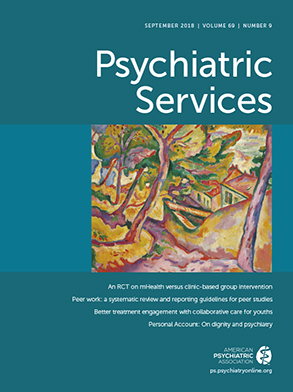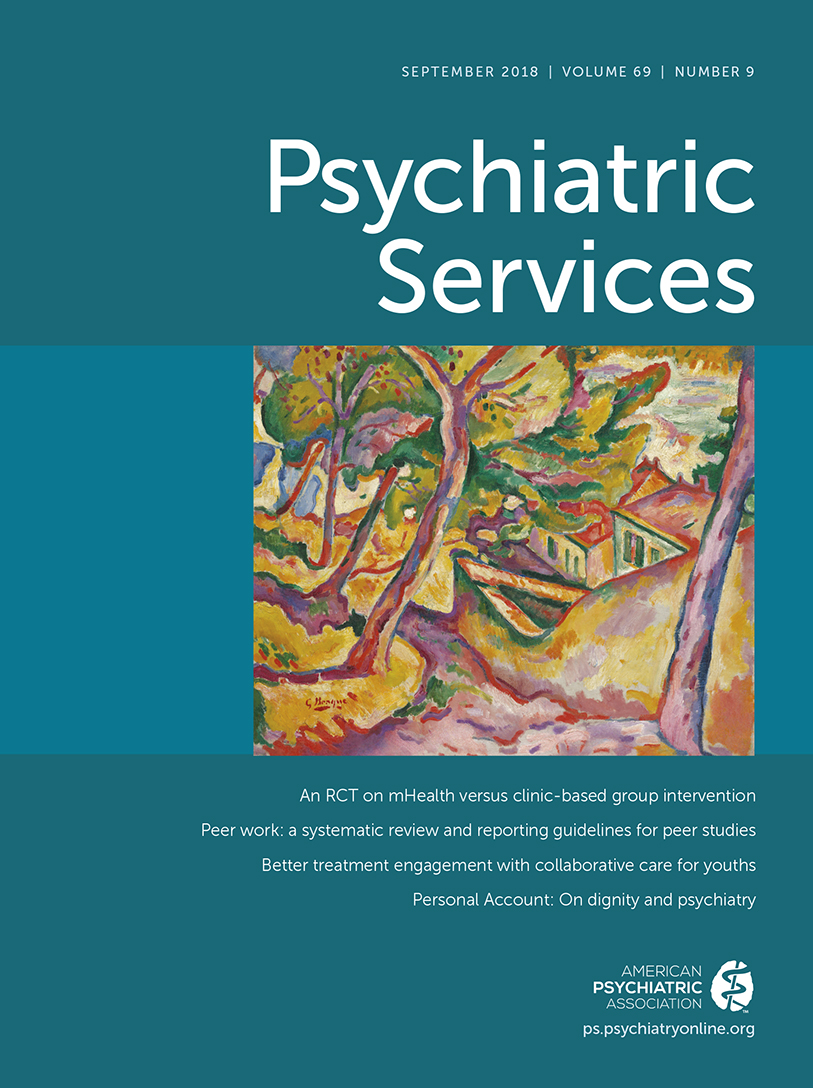Despite federal and state reforms to create alternative, less costly community-based systems of care and a reported shortage of psychiatric inpatient facilities for children and adolescents, utilization of inpatient psychiatric services for children and adolescents has increased in recent years (
1,
2). Although the overall rate of all-cause hospitalizations for children with private insurance coverage did not increase between 2006 and 2011, inpatient stays for behavioral health conditions in acute care, community hospitals increased by 35.3% for children and youths ages one to 17; the increase was 48.5% for children ages 10–14 (
3). Research using nationally representative data estimated that nearly 10% of inpatient hospitalizations for children, adolescents, and young adults age two to 20 at acute care, community hospitals (excluding psychiatric facilities) were for admissions with a primary mental health diagnosis (
4). Furthermore, a separate study found that U.S. hospitalizations for children and adolescents ages three to 17 increased at a rate five times greater for those with a psychiatric diagnosis than for those without such a diagnosis (
5).
Previous research on youths hospitalized for behavioral health conditions often has not included hospitalizations in specialty psychiatric facilities or has not distinguished between care in nonpsychiatric beds and psychiatric and detoxification beds in acute care hospitals. This analysis adds to previous research on inpatient psychiatric utilization for children and adolescents covered by private insurance by examining trends in hospital stays by whether they occurred in a nonpsychiatric bed in an acute care hospital, a psychiatric or detoxification bed in an acute care hospital, or a bed in a specialty psychiatric hospital.
Methods
The study design was a retrospective analysis of the Truven Health MarketScan Commercial Claims and Encounters database for the years 2009 and 2014. This deidentified database includes insurance claims from employees and dependents covered annually by participating large, self-insured employers and regional health plans. The MarketScan database captures all billed services, including inpatient services. MarketScan data come from all 50 states; Washington, D.C.; and Puerto Rico. There were more than 53 million beneficiaries in MarketScan in 2009 and nearly 48 million in 2014. There were more than 13 million individuals age two to 18 years in MarketScan in 2009 and nearly 11 million in 2014. We confined our analysis to children and youths ages two to 18 with at least one inpatient stay with a principal diagnosis of a behavioral health condition or a suicidal ideation V code (that is, “supplementary classification of factors influencing health status and contact with health services”) or intent-to-harm-self external cause of injury code (E code). We classified admissions into facility and bed type categories by using Truven Health Analytics provider type codes and revenue codes from the Uniform Billing (UB04) form associated with the inpatient stay. Payments in 2014 were adjusted to 2009 dollars to account for inflation by using the Consumer Price Index Inpatient Hospital Services component from the U.S. Department of Labor’s Bureau of Labor Statistics. We report p values from the two-tailed difference between two independent proportions tests and from differences in means for averages.
Results
There were 21,805 and 27,550 hospitalizations of youths for behavioral health conditions in MarketScan in 2009 and 2014, respectively. The percentage of individuals ages two to 18 with commercial insurance with one or more inpatient stays at acute care hospitals in psychiatric and detoxification beds increased from .092% in 2009 to .149% in 2014 (p<.001) (
Table 1). There were smaller increases in the percentage of commercially insured children and youths hospitalized in acute care hospitals in nonpsychiatric beds and specialty psychiatric hospitals. In 2009, .012% of youths were hospitalized in acute care hospitals in nonpsychiatric beds. In 2014, this percentage rose slightly to .019% (p<.001). In 2009, .033% of youths were hospitalized in specialty psychiatric hospitals. In 2014, this percentage rose slightly to .039% (p<.001).
Although the majority of patients were between the ages of 15 and 18, the proportion of admissions for children ages 11 to 14 increased by approximately three percentage points across all inpatient stay types (p<.01 for all inpatient stay types). An important trend from our results was that the proportion of females increased by about 10 percentage points from 2009 to 2014 in all inpatient-stay types (p<.01 for all inpatient-stay types). Principal diagnoses of mood disorders, which accounted for a majority of admissions to acute care hospital psychiatric and detoxification beds and specialty psychiatric hospitals, increased as a percentage of behavioral health admissions in those facilities between 2009 and 2014 (p<.01 for both bed types); however, mood disorders accounted for only about one-quarter of admissions to nonpsychiatric beds in acute care hospitals in both years. The percentage of hospitalizations with suicidal ideation or intent-to-harm-self codes increased by 17.8 to 30.0 percentage points between 2009 and 2014, depending on the inpatient stay type (p<.01 for all inpatient stay types). [Results by geographic region are available in an online supplement to this report.]
The percentage of hospitalizations with a readmission with a behavioral health diagnosis within 30 days ranged from 7.6% to 9.3% in 2009 and from 8.3% to 9.4% in 2014 across the three inpatient-stay types. The only statistically significant change from 2009 to 2014 was the increase in the percentage of hospitalizations with a readmission for acute care hospital psychiatric and detoxification beds (8.4% to 9.4%, p<.01). Psychiatric stays in a nonpsychiatric bed in an acute care hospital were the shortest of the three inpatient stay types (4.6 days in both 2009 and 2014, p<.001 for all facility types and both years), but they had highest average payment in both years (p<.001 for all facility types and both years). After removing the considerable hospital price inflation that occurred between 2009 and 2014, we found that the average payment in 2009 dollars for nonpsychiatric beds in acute care hospitals increased from $8,922 to $9,507; however, the difference was only marginally significant (p=.10). Average payments for the other two bed types dropped in 2009 dollars, falling from $7,520 to $6,903 (p<.001) for psychiatric and detoxification beds in acute care hospitals and from $6,228 to $5,834 for specialty psychiatric hospitals (p<.001).
Discussion
Using a large convenience sample of commercial health insurance claims, we found an increase in the number and percentage of youths being hospitalized for behavioral health conditions at acute care hospitals in nonpsychiatric beds and psychiatric and detoxification beds, as well as in specialty psychiatric hospitals. Carubia et al. (
6) found that between 2009 and 2012, the number of general inpatient psychiatric beds declined by 3,000, and the average wait time for an appointment with a child and adolescent psychiatrist was estimated to be nearly eight weeks.
The increase in demand for (and decrease in supply of) inpatient behavioral health services by youths has been accompanied by increases in demand for other behavioral health services. In addition to rising behavioral health care utilization among children admitted to the hospital, a review of the literature on child psychiatric emergencies indicated that over the past 15 years, the number of pediatric patients presenting to the emergency department in psychiatric crisis nearly doubled (
6). A retrospective cross-sectional analysis of the National Hospital Ambulatory Medical Care Survey–Emergency Department (
7) found that the percentage of emergency department visits that were for mental health conditions among children and adolescents ages six to 20 increased from 4.4% of all emergency department visits in 2001 to 7.2% in 2011.
Increases in utilization of behavioral health services by youths are not limited to hospital-based settings. An analysis of data from the Medical Expenditure Panel Surveys found that the percentage of youths receiving any outpatient mental health service increased from 9.2% in 1996–1998 to 13.3% in 2010; significant overall increases occurred in the use of psychotherapy (from 4.2% to 6.0%) and psychotropic medications (from 5.5% to 8.9%), including stimulants and related medications (from 4.0% to 6.6%), antidepressants (from 1.5% to 2.6%), and antipsychotic drugs (from .2% to 1.2%) (
8).
We found substantial increases in the number of youths with suicidal ideation or intent-to-harm-self codes in all three inpatient settings. Recent research indicates that the number of children and adolescents admitted to children’s hospitals for thoughts of suicide or self-harm more than doubled in the past decade (
9). Indeed, from 2007 through 2015, there was a doubling of rates of suicide among girls and a 30% increase among teenage boys and young men (
10). Research also indicates that rates of emergency department visit by youths for self-inflicted injuries were relatively stable before 2008 but increased significantly between 2009 and 2015, particularly among females ages 10 to 14 (
11). Using data from the MarketScan databases, a different analysis (
12) also showed that mental health services use for outpatient behavioral health therapy increased between 2007 and 2013, following the implementation of the Mental Health Parity and Addiction Equity Act in 2008.
Inflation-adjusted payments increased for stays in nonpsychiatric beds in acute care hospitals, although the change was only marginally significant. When using 2009 dollars, payments decreased for stays in psychiatric and detoxification beds in acute care hospitals and at specialty psychiatric hospitals. However, unadjusted payments for admissions to all three bed types increased. Medical inflation outpaced overall inflation during this period (
13); therefore, the increase in unadjusted payments for hospitalizations of youths for behavioral health conditions could potentially increase financial burden on patient families.
This analysis should be considered in light of a number of limitations. First, MarketScan captures only billed claims. It does not capture services that patients may have needed but did not receive or admissions that were paid for entirely out of pocket. Second, this analysis includes only inpatient stays by youths whose commercial insurance is captured in MarketScan. Although MarketScan includes the claims of millions of beneficiaries, the results may not generalize to patients whose commercial insurance does not participate in MarketScan, as well as to patients with a different form of insurance (e.g., Medicaid) or those who do not have insurance.
Conclusions
We found increases in the number and percentage of youths hospitalized for behavioral health conditions. The increase was largest for youths admitted to psychiatric and detoxification beds in acute care hospitals. We observed increases of 17.8 (N=526) to 30.0 (N=1,249) percentage points in hospitalizations of youths with suicidal ideation or self-harm injuries, depending on bed type. These trend statistics demonstrate the continued importance of inpatient psychiatric services for youths, especially for those experiencing suicidal thoughts and behaviors.

